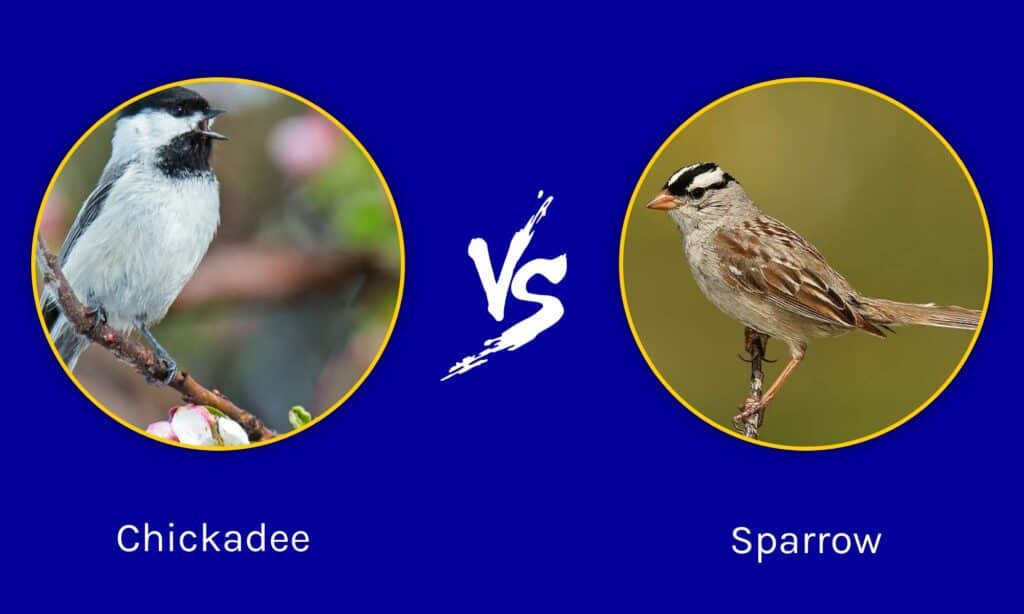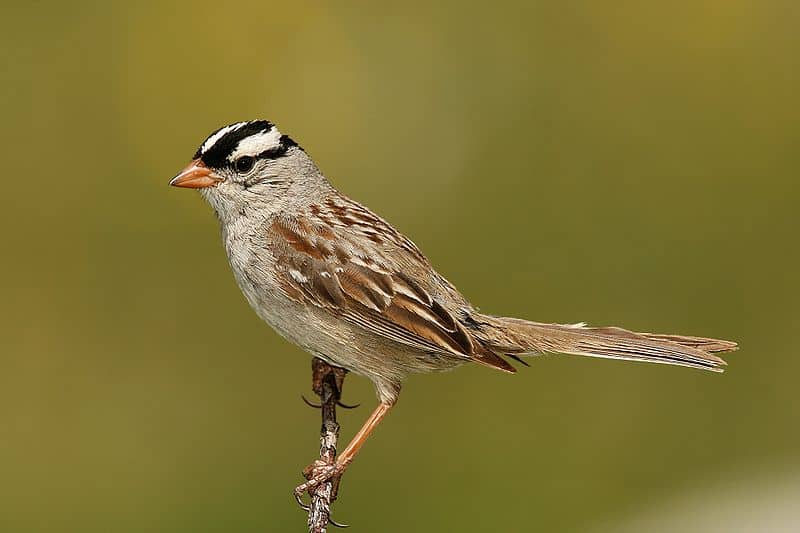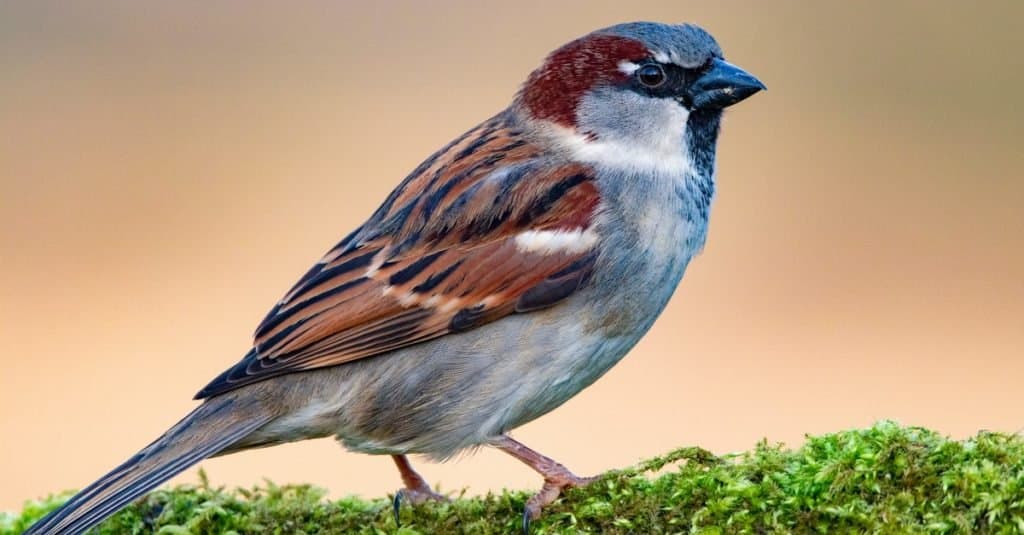Two of the most common groups of birds in the United States are the chickadees and the sparrows. For anyone just getting into birdwatching or who has simply taken an interest in the birds they see in their yards, these two can be tough to tell apart! Both of these birds can be found across most of North America, and they are incredible little creatures. Seeing them flit around is part of what makes birdwatching so amazing! Let’s compare the two and learn a bit about chickadees vs sparrows in a little more detail.
Comparing a chickadee and a sparrow

| Chickadee | Sparrow | |
|---|---|---|
| Size | 4.7-5.9 inches. Short neck, large head, and spherical body. | 5.5-7.9 inches. Elongated body. |
| Crown or cap | Large cap, usually black. | Multi-colored cap. |
| Throat patch | Distinct throat patch. | Usually only present in house sparrows. |
| Food caching | Professional food cacher. | No food caching. |
| Distribution | North America | Worldwide |
| Taxonomy and species | Belongs to the Poecile genus. | Belong to the Passerellidae and Passeridae families. |
The 6 main differences between a chickadee and a sparrow
The main difference between a chickadee and a sparrow is that chickadees are smaller, live exclusively in North America, and create food caches for the winter. Sparrows are larger, live all over the world, and have more elongated bodies.
Chickadees are members of the Poecile genus, a group of birds that can be found all over the world. Only North American members of the tit family that are included in the Poecile genus can be considered chickadees. Sparrows can be split into two groups that are New World sparrows and Old World sparrows. Between the two, they can be found on nearly every continent, save for Antarctica.
Aside from their evolution, these birds differ in size and habits. Chickadees are small, spherical birds that are famous for their habit of hiding food to eat during the winter. Sparrows are a bit longer and have a thinner appearance. Additionally, chickadees almost always have solid-colored caps and throat patches, while most New World sparrows have striped caps and no throat patch.
Let’s look at all these differences, plus a few more, in some detail below.
Chickadee vs Sparrow: Size

Sparrows are larger and more elongated than chickadees (pictured above is a sparrow).
Chickadees are extremely small, round birds. They usually measure 4-5 inches long, although their spherical features make them seem much smaller. Their heads are round, and they lack a distinct neck, plus their bodies are short and squat. Together, these features make for a cute, spherical bird that is smaller than a sparrow.
Sparrows aren’t large birds by any means, but they are larger than chickadees. Most sparrows measure between 5-7 inches and have a more elongated appearance. Sparrows have a more elliptical head and a clearer head-neck separation than chickadees. Additionally, their legs are usually longer, and their tails extend further. Together, these features make sparrows a longer, thinner-looking bird.
Chickadee vs Sparrow: Crown or cap

Chickadees have a solid-colored cap while most sparrows have a striped cap.
©Mr.Coffee/Shutterstock.com
While both chickadees and sparrows have caps, they both have a few distinct differences in how they are expressed. The cap of a chickadee is generally a solid color, most often black, and is usually accompanied by distinctly white cheeks. The eyes of the chickadee are often difficult to see as a result of their cap, giving birdwatchers another clue when identifying them.
Sparrows also have caps, but they are usually two-toned with a top color and a different side color extending from the eyes. The house sparrow, for example, has a brown extending from its eyes with a gray line completing the cap at the top. Most sparrows will have a stripe of some kind around their eyes or on the top of their head.
Chickadee vs Sparrow: Throat patch

Chickadees have a throat patch that reaches up to their beak.
©Rob Palmer Photography/Shutterstock.com
Another physical identifier, chickadees have a throat patch that is normally black. It doesn’t connect with their cap but is often the same color. Their throat patches end at the bottom of their neck and form a triangle up to their beak, where the point is formed.
Sparrows don’t generally have throat patches, although they can have varied colorations and patterns across their body. For chickadees, however, the throat patch is almost always present. One important note is in regards to the house sparrow. The house sparrow is an Old World sparrow that was introduced to North America, and it does have a form of a throat patch. The difference between the two is that the sparrow’s patch connects to a larger patch on its chest.
Chickadee vs Sparrow: Food caching

Chickadees are known to create food caches with up to 80,000 seeds hidden away. Sparrows (pictured above) do not.
©iStock.com/PaulReevesPhotography
Mountain chickadees are well known for their habit of finding, hiding, and retrieving food when times are scarce. Much like a squirrel, chickadees have an incredible ability to hide seeds and nuts in thousands of places, with some birds hiding as many as 80,000 seeds. Scientific testing showed that birds living in harsher environments had better memories, larger brains, and more neurons than birds living in places where food caching wasn’t necessary.
Sparrows eat seeds and nuts as their primary source of food. They are opportunistic, however, and will eat small insects and fruits if given the chance. Sparrows aren’t known to hide food in caches.
Chickadee vs Sparrow: Distribution

House sparrows are Old World sparrows that were introduced to America in the 1800s.
©Craig Howman/Shutterstock.com
Part of what separates chickadees from sparrows is their name and distribution. Although the overarching group of birds that chickadees belong to (Poecile) can be found worldwide, chickadees are native to North America. Any members of the Poecile genus in North America are referred to as chickadees.
Sparrows can be found all over the world, but they are further split into two groups. Sparrows that can be found in Europe, Asia, and Africa are known as Old World sparrows, and those found in the Americas are known as New World sparrows. New World sparrows are what people in the United States are familiar with, although the most common species (the house sparrow) was introduced from Europe.
Chickadee vs Sparrow: Taxonomy and species
Chickadees are North American tits that belong to the Poecile genus. The most common species are:
- Black-capped chickadee
- Boreal chickadee
- Carolina chickadee
- Chestnut-backed chickadee
- Grey-headed chickadee
- Mexican chickadee
- Mountain chickadee
Sparrows belong to either the Passerellidae or Passeridae families. The most common species in North America are:
- American Tree Sparrow
- Chipping Sparrow
- Clay-colored Sparrow
- Fox Sparrow
- Harris’s Sparrow
- LeConte’s Sparrow
- Lincoln’s Sparrow
- Nelson’s Sparrow
- Savannah Sparrow
- Song Sparrow
- Swamp Sparrow
- Vesper Sparrow
- White-crowned Sparrow
- White-throated Sparrow
- House Sparrow
The photo featured at the top of this post is © iStock.com/lgunderson
Thank you for reading! Have some feedback for us? Contact the AZ Animals editorial team.






